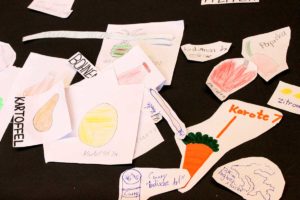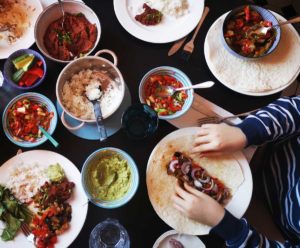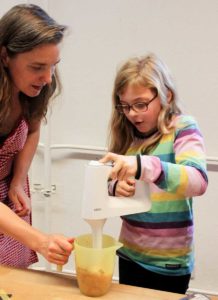Honoring the Leftovers
Welcome to July!
With all the fresh produce and food this time of year offers, I’d like to share the story behind one of my creativity workshops, Color Food Fun.
As an artist and a mother, I take a lot of inspiration from my kids’ playfulness, curiosity and their willingness to try out new things. When my son was learning about the different aspects of food production in school, I offered to give a workshop on food waste reduction. As some of you may know, I love an opportunity to improvise! Why not see how children could learn about the political aspects of food using leftovers?
 I asked parents to send their child to school with a cutting board and one ‘leftover’ food item from the fridge. In a sense, it was going to be an experiment about how we can change our relationship to food. And what better group than kids with little or no experience with cooking!
I asked parents to send their child to school with a cutting board and one ‘leftover’ food item from the fridge. In a sense, it was going to be an experiment about how we can change our relationship to food. And what better group than kids with little or no experience with cooking!
As an interdisciplinary artist, process and connections are a major theme in my work. I wanted the children to spend time with whatever they brought and form a connection through making drawings of their carrot, tomato or cabbage.
It became so personal for each child, like a poetic act of honoring the food.
After cutting out their drawings, they made a big collage together – grouping colors, types of food and possible relationships. The food became little islands of ‘players’. I was so thrilled to see their excitement and joy as they formed cooking groups based on the organization of the collage. I stood back and let them be the creators unless they needed help.
The energetic community of these young chefs was so beautiful to watch!
At the end, we shared in this delicious and unexpected buffet. The kids wanted to taste everything which is unusual because children can be quite picky. Food became an exciting adventure in how to look at it, how to serve it and how to taste it.
Afterwards, parents called to tell me how much fun their child had and how it had triggered a lot of reflection about food. The political aspect had been felt through the different processes, subtly woven into the experience.

I took what I had learned from the workshop and brought it back to my office. Once a month, I asked my colleagues to bring in one food item or leftovers from home. I then created a big lunchtime communal meal. As we ate, people would try and guess which part of the meal incorporated their special ingredient. Instead of the usual lunch of grabbing take out and eating at their desks, we became an engaged group sharing food together.
I’d love to invite you to do this with your children and friends. Plan a dinner party where everyone brings something and co-create a meal together. Set the table and welcome in a spontaneous creative atmosphere. It may feel a bit strange to put the recipes and planning aside, but as the kids taught me, isn’t that part of the fun?
Happy experimenting!
Ines
Honoring the Leftovers Read More »


